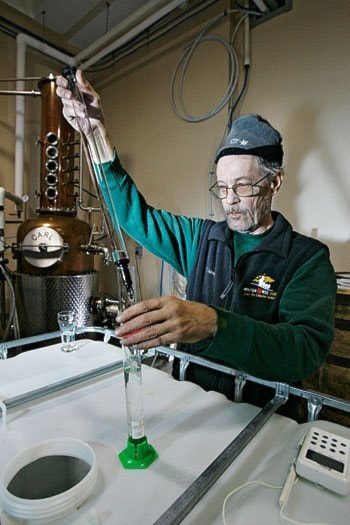Al Hansen is an alcohol alchemist.
In his steaming, malty lab, the co-owner of Yukon Brewery holds a test tube of clear, pungent liquor.
Behind him, a huge stainless steel vat with submarine-like hatches sits beneath a brass cylinder that resembles an enormous steam whistle. It features a thick glass window that is covered in condensation.
Hansen shines a flashlight up through the brass-framed window, revealing clear liquid dripping from tiny copper pipes.
At this point, the liquor is 75 per cent alcohol.
Hansen jury-rigged the still himself, popping the top off his beer kettle and fitting on the steam-whistle-like contraption with its pressure gauges, pipes and shiny “condenser” tube.
For the last few years, he’s been mashing grains, separating the sugars and then fermenting them with yeast.
From this, he distills a strong, malty alcohol - a sour “whiskey beer” the colour of chocolate milk that’s 12 per cent alcohol.
By the time it’s gone through his home-built still, and a smaller, European still with similar portals and gauges, the alcohol is clear and strong.
Hansen waters it down to 70 per cent before placing it in used bourbon barrels that will eventually turn it into whiskey.
Already, a corner of the brewery is devoted to stacks of the worn oak barrels aging the high-test spirit.
It takes three years of aging before this strong stuff can be called whiskey.
So, in the interim, Hansen kept on experimenting.
Filling his still with grain alcohol shipped up from the Prairies, Hansen started tossing in various Yukon ingredients.
“I tried Saskatoon berries,” he said.
But they weren’t strong enough.
The distillation process destroyed their flavour.
As the alcohol rises past each little portal, it passes through a plate, making it purer and purer.
Spruce tips have a much stronger flavour, but they never made it into the still.
“Spruce tips aren’t appealing to my palate,” said Hansen.
The combination that stuck mixes sage, raspberries and rosehips.
“We chose them because they are all indigenous to the Yukon,” said Yukon Brewery marketing director Neil Stephen.
The resulting aromatic alcohol is not vodka.
“Everybody and their dog makes vodka,” said Hansen.
It’s not rum, either.
And it’s not gin.
“It’s a unique northern spirit,” said Stephen.
“In beer and spirits, we don’t let categories shape our products,” he said.
“We create something that tastes good and then see what genre it fits into.”
Yukon Brewing named the new spirit Solstice and has already been experimenting with Solstice sours, Solitos (a northern take on the mojito) and the sundog, a Solstice martini with some cranberry and a curled lemon rind at its centre.
Hansen was asked to come up with a recipe too, but so far he hasn’t got past Solstice on the rocks.
As it climbs through the still, the spirit passes through copper pipes to help break down the sulphur compounds, making it smooth.
The leftover mix of sage, raspberries and rosehips in the bottom of the still makes an awesome ice cream topping, said Stephen.
“It’s also good on salad.”
Solstice is made in the smaller European still and doesn’t need aging.
It’s only the whiskey that needs to be cooked up and distilled in the jury-rigged beer kettle.
When Hansen decides to mix up a batch of whiskey, beer making goes on hold.
The top of the beer kettle is removed and it’s refitted with the homemade steam-whistle still - a process that takes about half a day.
It takes another three days to distill a 10,000-litre batch of whiskey.
The barrels are shipped up from the southeast US. There’s a rule down there that every batch of bourbon needs new barrels, so the used bourbon barrels are shipped to whiskey makers around the world.
The bourbon in the wood will add a taste to the whiskey, and Hansen, ever the scientist, is experimenting with some sherry casks as well, to discover the difference in taste.
But all this is several years away.
In the interim, Hansen is focusing on Solstice.
Unlike beer, which is costly to ship Outside, hard liquor makes for good marketing.
Yukon Brewing sells its beer in Alberta and BC, with Alberta being the much more lucrative of the two.
But beer has a shelf life, said Hansen.
“And shipping out a pallet of beer, might be worth about $5,000,” he said.
“While shipping out a pallet of liquor will be worth more like $60,000 to $70,000.
“So it’s a product that makes more sense to ship across the country.”
Solstice went on sale in Yukon liquor stores today for $44.95.
It’s hand-bottled at the brewery, just like the beer.
In the winter, beer sales used to drop off, and Hansen had a hard time finding enough work for his staff.
That’s when he started experimenting with liquor.
Now, with his kettle tied up making whiskey, and staff running around with test tubes measuring alcohol levels, the brewery is hopping.
“And of course, now, beer sales aren’t as slow in the winter,” said Hansen with a grin.
Contact Genesee Keevil at
gkeevil@yukon-news.com
